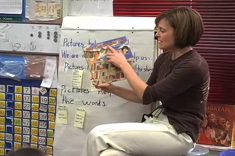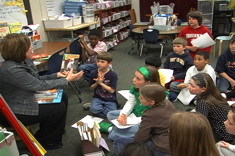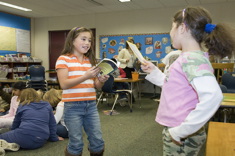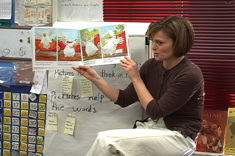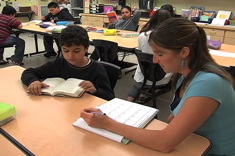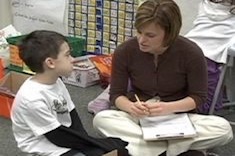One of my first goals at the beginning of the year for my first and second graders is to help them find and choose books to fill their book bins. With such young readers, I know I can best support this goal by reading aloud many books that I know they will love. Last fall after a month of introducing routines, assessment, and inviting kids to think about what we love about reading, I began a series study with a few specific goals in mind.
First, I wanted to get books in students' hands. I knew series books (multiple books about one or more characters) would lend themselves to more reading after sharing one book. Second, I wanted kids to explore the books in our classroom library and become familiar with the picture books and early chapter books that are in a series. Third, I wanted them to think about features of text. I find that when students are familiar with features of text that support them as readers, they have an easier time finding just-right books without being nagged all the time about whether is it "just right." Finally, I wanted children to have opportunities to get to know and think about characters in stories more deeply.
Introducing the Study
Katie Wood Ray in her book In Pictures and In Words writes that in a unit of study, students are active co-creators of curriculum. Student partnership in teaching drives learning. I love this quote from her book: "Adults always learn from children. Children just notice more than we do. It's that simple."
To begin the unit, I started gathering series books (including many picture books) for students to investigate. I asked the kids to look through a series with a partner and to share what they noticed. I modeled first how to make observations about how the books in the series are the same and different. I knew some partnerships could make these comparisons easily, and I invited students to begin reading the books after I modeled the initial preview.
I wasn't worried about the kids finishing the books, or even starting to read for that matter. I just wanted them to handle and start noticing things in the books. For the kids that read further and discovered more, their thinking was shared and helped teach the larger group how to go deeper in their partnerships. When students were ready to share their ideas about what makes a series a series, I helped scaffold the discussion with questions like:
What do you notice about the books in a series?
How are they the same?
How are they different?
Why would an author want to write a series?
How do series books help us as readers?
What do you like about series books?
Discussion about their thoughts and the guiding questions helped us begin to understand what kinds of books fit into the category of "series." Here are some initial observations shared by the students:
There is more than one book in a series;
Characters stay the same in the books;
Sometimes there are new characters in later books of a series;
Some books have the similar words in the title (Henry And Mudge, Mr. and Mrs. Green
);
Some series titles use different words;
Some books are small in size and some are bigger;
Some series books have chapters;
Some books don't have chapters;
Some series books have sections; and
Series books can be about animals or people.
Taking Time to Read Aloud
I began with these initial student observations and shared other basic features of primary series books that I wanted them to notice (like repeating phrases or language, setting and changes in setting, and amount of time that goes by for the characters in the story). These observations guided us in many conversations as kids explored series books for a few days. I then took time to read aloud many different primary series books (Iris and Walter, Cowgirl Kate
, Mr. and Mrs. Green
, and Henry And Mudge
, to name a few).
As I read aloud, students discussed characteristics of series books that they were noticing. I sometimes previewed series books by showing the book, reading the back of the book or inside cover and then the first page, instead of reading aloud the entire book. This naturally piqued the interest of students, and left them wanting to explore the book and others in the series.
Sorting Series
After the initial work of identifying series books and getting started, I asked the students to help me sort series books. I wanted them to consider what "supports" (qualities or text features) different series books might have that could help them make choices independently. Students noticed if the book had many or no pictures, few words or lots of words on a page, and short or longer chapters. We decided general criteria for each category by what we noticed about text, pictures and general understanding for a typical book that represented each category. Then I had students work with a partner to sort titles, and we discussed partner placements of series in the three categories. Here is what we came up with after much discussion and sometimes debate, reminding students that there is no right or wrong place to categorize.
In first grade we had a basket of books labeled "Books We Can All Read." In second grade, we decide to sort some series into a similar category, "Easy Reads" (books we all enjoy and can read words independently). I like this category, because it creates a place where all readers have equality regardless of reading ability. Strong to struggling readers read and love these books, and they are accessible for all to grab and read. The category and its popularity take away the competition that occurs when chapter books begin to make their way into the classroom. Children noticed that books like Dog and Bear and Elephant and Piggie
books have pictures on every page, not too many words on a page, and we can read and think about what is happening in the story by ourselves.
We also created a category titled "Early Readers." We noticed that books like Mr. and Mrs. Green, Henry And Mudge
, Fly Guy
, Baby Brains
and Scaredy Squirrel
have less words than chapter books, short chapters or short stories, as well as lots of pictures to help us read the words. But this category requires more thinking than "Easy Reads." We noticed that most of the series books in our library fit into the "Early Reader"category, because we are just beginning to read series.
Finally, we decide that the chapter books in a series like Roscoe Riley, Stink
, Flat Stanley
, and Ivy & Bean
have many words on each page. They have fewer pictures, and the stories have more to remember and think about because so much is happening. Readers need to be able to envision and imagine the story in their minds all the time. There are lots of pages and the books might require you to keep reading over days. We talked about how chapter books require lots of thinking for readers. I was careful in my choices of what I read aloud. I balanced reading aloud lots of picture books with early reader books, saving the read-aloud chapter books for a time other than reading workshop.
Giving Kids Time to Read, Talk and Think
To solidify some of the work we were doing to understanding features of series books and help everyone get started with series reading independently, I asked the students to partner up and explore a series together. They could choose from the Easy Reads or Early Readers categories. This allowed them time to preview series they may not have explored yet, read with a partner, and share what they found.
I created a form for the students to track what they noticed about the series. Ashley and Rupa explored the series Mr. Putter & Tabby and their findings are included here:
I see that they can identify basic text and story features in their responses. They recognize that Mr. Putter & Tabby Walk the Dog is one big story, and they identify Zeke, Mr. Putter, Mrs. Teabody and Tabby as characters. They find that the story takes place in the front yard of the Teabody's home and in Mr. Putter's clubhouse. They also notice that the story occurs over two days. Both readers were exposed to a new series, and one reader has even said she would read the series because it is serious and funny.
Looking back at the form, it seems a little simplistic at first glance, with my questions about why others might like the book, or favorite parts and characters in the story. But I remember thinking at the time that it would help me assess if kids were understanding some of the series features we had been studying.
The form was basic enough for seven-year-olds to read, write, and process easily with a peer. It also gave me information about what kids weren't grasping in our study. For example, I noticed that not one partnership mentioned repeating words or phrases when they explored a series with a partner. I knew that they most likely didn't understand what I was asking, or had trouble picking them out of the story. I decided to use this gap in learning to re-teach and explore just what repeating words and phrases sound like, as well as which series books have them.
I read aloud an example from the Cowgirl Kate series to point out repetitive language that some series books incorporate. I read aloud Cowgirl Kate and Cocoa
by Erica Silverman. I told the children that Cocoa is a horse who is best friends with Cowgirl Kate, and they are always helping one another, even when they don't feel like it. I then asked the kids to pay attention to Cocoa's dialogue (I also gave a brief explanation that this means "talking"), because Cocoa likes to repeat and say the same thing again and again.
After reading Chapter 1, A Story for Cocoa and Chapter 3, Counting Cows (I picked these two short story chapters to share the same repeating phrase), the kids noticed that Cocoa is often saying "I'm hungry." We talk about why the character would say this. Some children thought it was because horses eat a lot. I then pulled other series books like Mercy Watson and the Lily Books (Julius, the Baby of the World
, Lilly's Purple Plastic Purse
, and Lilly's Big Day
written by Kevin Henkes) that have repetitive language. I asked kids to read one of the series books with a partner, locate repeated language or phrases, and then reflect on why the author might use the repeating words in the story.
Jac and Adam worked together and read Julius, the Baby of the World by Kevin Henkes. They found the repeating language was I hate you and I have an idea, both used by Lily throughout the story. After finding these repetitive phrases, they decided Lily might say these words repeatedly because she wanted to be king of the family (she hated having attention taken away from her after her baby brother Julius was born). If you are familiar with Lily from these stories, you know she definitely likes to take charge. While identifying repeating language, students like Jac and Adam had opportunities to read series books, identify characteristics of the books, and then reflect on the characters.
In Part 2, I conclude my explanation of the series unit by sharing how students developed comprehension skills as we continued our work in this unit.

